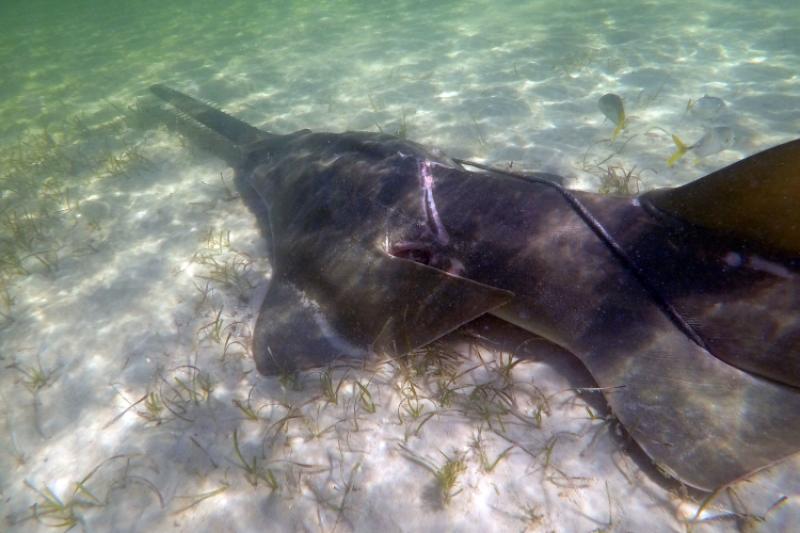Sawfish Alert! The endangered smalltooth sawfish is frequenting Biscayne Bay. A new paper documents its presence, as well as the historic record back to 1895 of its past presence in the Bay.
“No wonder scientists are finding smalltooth sawfish in Biscayne Bay. Even Miami residents can see them from their condominium windows,” says Tom Jackson, one of the NOAA authors. The new paper documents the presence of at least 14 individual sawfish (including both sexes, adults, and juveniles). They were seen in the NOAA Biscayne Bay Habitat Focus Area (Biscayne Bay and parallel reef tract) between 2017 and 2020. Some individuals appeared numerous times in acoustic records of the same day, separate months, or even separate years. The paper also notes that the rate of entry of sawfish records into the International Sawfish Encounter Database increased after the year 2000.
“Finding smalltooth sawfish in Biscayne Bay highlights the importance of plans by the Comprehensive Everglades Restoration Project to restore sheet flow through hydrologically disconnected stands of mangrove lining Biscayne Bay,” according to Dr. Joan Browder, NOAA Fisheries biologist and corresponding author on this study. “Previous studies indicate that shallow waters in mangrove areas receiving freshwater inflow provide ideal nursery habitat for this species.” She went on to say, “The presence of sawfish in the Bay indicates a need for public outreach, as in other parts of its range, so that citizens of Miami can better understand and protect this unique species. Our results should lead to long-term monitoring and study of this species beyond currently established study sites.”
Biscayne Bay was declared a Habitat Focus Area by NOAA in 2015, and the Southeast Fisheries Science Center in Miami is one of its local NOAA sponsors. One goal was to learn more about the federally listed endangered smalltooth sawfish. We had recent anecdotal information that they were present in Biscayne Bay. Documentation of the presence of the species in Biscayne Bay and nearby Atlantic waters seemed well-aligned with Focus Area project goals.
According to the 2009 NOAA Fisheries Smalltooth Sawfish Recovery Plan, the lower southwest Florida coast is the documented U.S. nursery area for this species. Large aggregations of adults are known to occur in the Jupiter Inlet area about a hundred miles north of Biscayne Bay on the Florida east coast. The Biscayne Bay Habitat Focus Area seemed, at a minimum, a likely inshore travel route between the two documented sites. Furthermore, smalltooth sawfish might find satisfactory nursery habitat along southwestern Biscayne Bay’s miles of shoreline lined with mangroves and waters less than one meter deep.
Project Development
The sawfish project started with a chance conversation of Miami Center research biologist Tom Jackson, the Biscayne Bay Habitat Focus Area coordinator, with a local resident, who said he had seen a sawfish in Biscayne Bay “last week”. Jackson was aware of a shark acoustic project being conducted by the University of Miami’s Shark Research and Conservation Program, The program is run out of the Rosenstiel School of Marine and Atmospheric Science and is led by Dr. Neil Hammerschlag. Tom also knew that NOAA has a sawfish acoustic tagging program. The new knowledge that a sawfish had been seen in the bay recently led him to approach Dr. Hammerschlag. Jackson suggested that Hammerschlag expand the geographic range of his study and notify NOAA of any sawfish incidentally detected.
Hammerschlag agreed to an expanded study with Jackson’s involvement. Between 2015 and 2020, Jackson coordinated field boat logistics for acoustic array operations and captained NOAA small boats. These efforts were augmented by LTJG Justin Boeck, NOAA Corps, who captained the larger R/V Aldo for offshore work. Jackson also suggested sites for acoustic receiver deployments. He helped Dr. Hammerschlag acquire, deploy, maintain, and download data from 40 acoustic receivers operating from 2017 through 2020 and into the future. The project was also supported by Shark Research and Conservation data coordinator Stephen Caine and graduate student Mitchell Rider. They coordinated the receiver downloads, data management, and preparation for redeployment for the next data cycle, often within less than 48 hours. Ph.D. student Laura McDonnell began organizing the data and scientific information about sawfish in the Biscayne Bay area, leading the manuscript data analysis and writing.
Research Collaboration
The Biscayne Bay sawfish research is a collaboration of the NOAA Fisheries’ Southeast Fisheries Science Center scientists in Miami and the University of Miami Shark Research and Conservation Program at the Rosenstiel School of Marine and Atmospheric Science. Historic perspective was provided by records from the International Sawfish Encounter Database (then managed by Dr. George Burgess). Additional historical data were acquired by the Miami Center’s library researcher Helen Albertson through a search of old naturalist and fisheries texts and newspaper accounts.
The contemporary account was acquired incidentally by the Shark Research and Conservation program from acoustic receivers, baited remote underwater video cameras, and incidental captures on drumlines. Other authors, Austin Gallagher and videographer Lindsay Phoenix, provided early underwater video of sawfish in the Habitat Focus Area.
Smalltooth sawfish are an endangered species. All sawfish tagging operations supporting this study were conducted under guidelines in ESA permits.
Contact: Joan Browder



